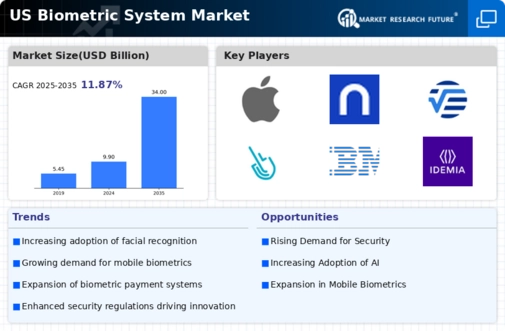Rising Consumer Awareness and Acceptance
Consumer awareness and acceptance of biometric technologies are on the rise, significantly influencing the biometric system market. As individuals become more familiar with biometric authentication methods, such as facial recognition and fingerprint scanning, their willingness to adopt these technologies increases. Surveys indicate that approximately 70% of consumers in the US are open to using biometric systems for secure transactions and identity verification. This growing acceptance is driven by the perceived convenience and enhanced security that biometric solutions offer. As more businesses implement these technologies, consumer confidence is likely to grow, further propelling the market. The biometric system market is expected to benefit from this trend, as organizations leverage consumer demand for secure and user-friendly authentication methods.
Rising Demand for Enhanced Security Solutions
The biometric system market is experiencing a notable surge in demand for advanced security solutions across various sectors. Organizations are increasingly recognizing the limitations of traditional security measures, such as passwords and PINs, which are often vulnerable to breaches. As a result, the market is projected to grow at a CAGR of approximately 15% from 2025 to 2030. This growth is driven by the need for more reliable authentication methods that biometric systems provide, including fingerprint recognition, facial recognition, and iris scanning. The increasing frequency of cyber threats and data breaches further propels the adoption of biometric technologies, as businesses seek to safeguard sensitive information and maintain customer trust. Consequently, the biometric system market is poised to expand significantly as organizations prioritize security and invest in innovative solutions.
Increased Investment in Smart City Initiatives
Increased investment in smart city initiatives across the US is positively impacting the biometric system market. As urban areas strive to enhance public safety and improve infrastructure, biometric technologies are being integrated into various applications, such as surveillance systems and access control. Cities are recognizing the potential of biometric systems to facilitate efficient monitoring and management of public spaces. For instance, biometric-enabled surveillance cameras can help law enforcement agencies quickly identify individuals in crowded areas. This trend is expected to drive market growth, with estimates suggesting that the smart city sector could reach a valuation of $1 trillion by 2030. Consequently, the biometric system market is likely to see substantial opportunities as municipalities invest in innovative technologies to create safer and more efficient urban environments.
Technological Advancements in Biometric Systems
Technological advancements are playing a pivotal role in shaping the biometric system market. Innovations in artificial intelligence (AI) and machine learning are enhancing the accuracy and efficiency of biometric recognition systems. For instance, AI algorithms are improving facial recognition capabilities, enabling systems to function effectively in diverse lighting conditions and angles. The integration of these technologies is expected to drive market growth, with projections indicating a potential market value of $30 billion by 2030. Furthermore, advancements in sensor technology are leading to the development of more compact and cost-effective biometric devices, making them accessible to a broader range of industries. As these technologies continue to evolve, the biometric system market is likely to witness increased adoption across various applications, including law enforcement, healthcare, and financial services.
Growing Need for Identity Verification in Financial Services
The biometric system market is significantly influenced by the growing need for robust identity verification solutions in the financial services sector. With the rise of online banking and digital transactions, financial institutions are increasingly adopting biometric technologies to enhance security and streamline customer experiences. According to recent data, approximately 40% of banks in the US have implemented biometric authentication methods, such as fingerprint and voice recognition, to mitigate fraud risks. This trend is expected to continue, as regulatory bodies emphasize the importance of secure identity verification processes. This shift is likely to benefit the biometric system market as financial institutions seek to comply with regulations while providing seamless and secure services.






















Leave a Comment